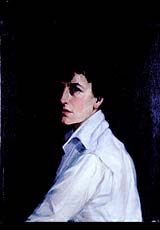 |

|
 |
Nasta Rojc
1883.
1964.
Education:
With Oton Iveković,( Zagreb, 1901/1902); with Tina Blau-Lang, (Vienna 1904/1906)
Kunstschule für Frauen und Mädchen, (Vienna, 1902-1904 and 1908-1911), Frauen Akademie, (Munich, 1907)
|
| Biography: It is difficult to summarise the implication of the words of Matko Peić, member of the Academy: "Who has experienced so much, both as a woman and a painter, as this Amazon of our painting". Daughter of the Secretary for Education and Religious Affairs, as a frail child she preferred playing with a real hunting gun than with dolls. Later, when she was a young painter, a gun was her favourite element of the setting of her self portraits, especially together with her mare Lenka who accompanied her roaming in the fields of the family estate at Gudovac near Bjelovar. In 1910, she married Branko, the tender son of the famous Croatian 19th century writer August Šenoa. After the First World War, her acquaintance with the English Lady Alexandrina Onslow (who was decorated for her courageous rescue and transport of the wounded) opened a new chapter in Nasta's life. In the summer of 1924, on Alexandrina Onslow's yacht, an accompanied by Oscar Kokoschka, Nasta experienced the delights of sailing and painting the Adriatic scenery from the deck. At Christmas 1924, Nasta was already painting the Scottish countryside on the estates of Miss Onslow's friends. Nasta's exhibition in London in June 1926 and later in Zagreb, in November, represented a decisive struggle in her endeavours to prove the Croatian art critics and the public that works of art at an exhibition were no less valuable because they were painted by a woman. Namely, the same London exhibition which was given the best review and recognition, was received with deliberate derision in Zagreb. The fighting Nasta found in this disdain a source of strength to group other women painters who wanted to gain recognition for their work. Their efforts were successful when, on 11 September 1927, Ministry of the Interior in Belgrade approved the regulations of the Women Artists' Club. It was not only the first association of women artists in Croatia, but also the first professional association of women from the Alps to the Aegean sea. (Together with Nasta Rojc, a very significant role, particularly for the official recognition of the Club was played by the eminence grise of this struggle, thanks to her relations with the Belgrade Royal court, especially Queen Mary. This self-denying person working behind the scene was Lady Onslow.) |
|
|






